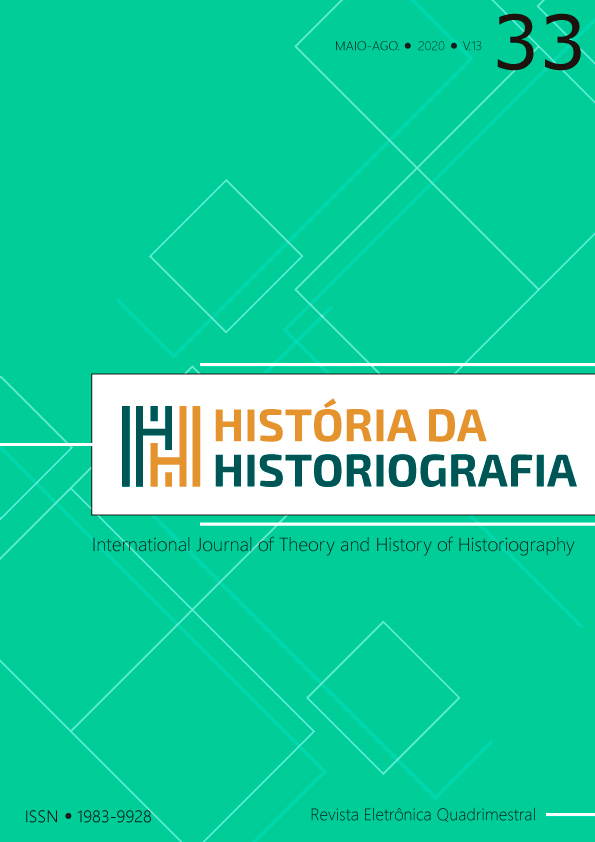Tyrant, madman and arsonist
BolsoNero. Analysis of the constitution of assimilation between the President of the Republic of Brazil and the Roman Emperor as allelopoiesis
DOI:
https://doi.org/10.15848/hh.v13i33.1573Keywords:
Nero, Bolsonaro, uses of historyAbstract
Over the centuries and with the use of multiple languages produced by various cultures, Emperor Nero became quite the universal symbol of tyranny. Mainly associated with madness and destruction, remembering Nero has served to criticize various rulers who lived after him and committed crimes that could somehow be linked to those attributed to Nero. Such approaches varied a lot over time and space and allowed the constitution of a broad and multifaceted repertoire of Neros produced in politics, literature, cinema, music, etc. This repertoire fostered a tradition composed of the association of the “original” Nero with the various characters and contexts of the “new” Neros. This tradition allowed both a new interpretation of the past and an original reading of the present. Thus, there is a reciprocal and simultaneous construction of the past(s) and the present, generating an allelopoiesis process, producing Neros that do not belong exclusively to the past or the present, but inextricably merge and confuse these temporalities. This process originated different syntheses that communicate ideas through a tradition in the form of repertoire to be appropriated and modified multiple times. This article focuses on the case of the President of the Republic of Brazil, Jair Bolsonaro, nicknamed BolsoNero.
Downloads
References
ASSIS, Machado de. Dom Casmurro. In: COUTINHO, Afrânio (org.) Obra completa de Machado de Assis. V. 1. Rio de Janeiro: Nova Aguilar, 2004.
“BolsoNero - Brazil’s president fiddles as a pandemic looms”. The economist. London. 26th March 2020. Disponível em: https://www.economist.com/the-americas/2020/03/26/brazils-president-fiddles-as-a-pandemic-looms. Acesso em: 28 mar. 2020.
CHAMPLIN, Edward. Nero. Cambridge: Harvard University Press, 2003.
DIAS, Mamede Q. Imperador ou tirano: Comunicação e formas sociopolíticas sob(re) o Principado de Domiciano (81-96). Tese (Doutorado em História). Mariana: Programa de Pós-Graduação em História, Universidade Federal de Ouro Preto, 2019.
FERRI, Rolando. Octauia. A play attributed to Seneca. Cambridge: Cambridge University Press, 2003.
FREUDENBURG, Kirk. “Donald Trump and Rome's Mad Emperors”. Common dreams, 29 de abril de 2018. Disponível em: https://www.commondreams.org/views/2018/04/29/donald-trump-and-romes-mad-emperors. Acesso em: 22 dez. 2019.
GRIFFIN, Miriam T. “Nero from zero to hero”. In: BUCKLEY, Emma; DINTER, Martin T. A companion to the Neronian age. London: Blackwell, 2013.
GRIFFIN, Miriam T. Nero: The end of a dynasty. London: Routledge, 1984.
GUARINELLO, Norberto Luiz. História Antiga. Campinas: Contexto, 2014.
HAUSTEINER, Eva Marlene; HUHNHOLZ, Sebastian; WALTER, Marco. Imperial interpretations: The imperium romanum as a category of political reflexion. Mediterraneo Antico. Roma: Fabrizio Serra Editore, 2010, anno 12, fascicolo 1-2, p. 11-15.
JOLY, Fábio Duarte; FAVERSANI, Fábio. “Os Júlio-Cláudios”. In: BRANDÃO, José Luís; OLIVEIRA, Francisco. História de Roma. V. II. Coimbra: Imprensa da Universidade de Coimbra, 2019. p. 79-95.
LANGLANDS, Rebecca. Exemplary ethics in Ancient Rome. Cambridge: Cambridge University Press, 2018.
LEIGH, Matthew. "Nero the Performer." In: BARTSCH, Shadi; FREUDENBURG, Kirk, LITTLEWOOD, Cedric A. J. (eds.). The Cambridge companion to the age of Nero. Cambridge: Cambridge University Press, 2017. p. 21-33.
MAIER, Harry O. “Nero in Jewish and Chistian tradition from the first century to the Reformation”. In: BUCKLEY, Emma; DINTER, Martin T. A companion to the Neronian age. London: Blackwell, 2013. p. 385-404.
PEREIRA, Mateus Henrique de Faria. “Nova direita? Guerras de memória em tempos de Comissão da Verdade (2012-2014)”. Varia Historia, Belo Horizonte, v. 31, n. 57, set./dez., p. 863-902, 2015. Disponível em: https://doi.org/10.1590/0104-87752015000300008. Acesso em: 22 dez. 2019.
PUCCI, Giuseppe. “Nerone superstar”. In: TOMEI, Maria Antonieta; REA, Rossella (cur.) Nerone. Roma: Electa; Ministero per i beni e le attività culturali; Spoprintendenza speciale per i Beni archeologici di Roma, 2011. p. 62-75.
ROLLER, Matthew B. Models from the past in Roman culture: a world of exempla. Cambridge: Cambridge University Press, 2018.
SHIM, Elizabeth. “Defector compares North Korea's Kim Jong Un to Roman emperor Nero”. UPI (United Press International), world news, de 7 de março de 2017. Acessado em 21 de abril de 2020. https://www.upi.com/Top_News/World-News/2017/03/07/Defector-compares-North-Koreas-Kim-Jong-Un-to-Roman-emperor-Nero/6951488911017/. Acesso em: 22 dez. 2019.
TOMEI, Maria Antonieta; REA, Rossella (cur.) Nerone. Roma: Electa; Ministero per i beni e le attività culturali; Spoprintendenza speciale per i Beni archeologici di Roma, 2011.
WINTERLING, Aloys. “Loucura imperial na Roma Antiga”. História. Franca: Unesp, v. 31. n. 1, jan. jun. 2012.
Downloads
Published
How to Cite
Issue
Section
License
Authors hold the copyrights to the manuscripts submitted. História da Historiografia: International Journal for Theory and History of Historiography is authorized to publish the aforementioned text. Authors are solely responsible for data, concepts and opinions presented in the papers, along with the accuracy of document and bibliographical references.

This work is licensed under a Creative Commons Attribution 4.0 International License.


















